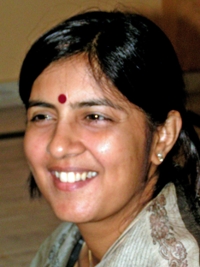Vow Four:
I will believe in human unity. I will not discriminate on the basis of caste, color etc., I will not treat anyone as an untouchable.
The fourth vow is also grouped in ahimsa, but it even combines some of the category of satya (truth telling). Tulsi poses a question as noted in the philosophy of the movement, "An evil may be untouchable, dirt or an ailment may be untouchable, but how can a man [or a woman] be untouchable?"[96] It is a significant question for humanity to think about because the conditions of our birth is not within anyone's choice, so how can there be a disparity of caste, creed, color or sex because of birth. Which theory purports such differences within humanity? The caste system in India, rooted in religion have pervaded throughout Indian societies. It was originally determined either by birth or by one's profession, for example, a Brahmin's (priestly class) son would be a Brahmin. Eventually, the way the caste system was interpreted and implemented served as the root cause of disparity.
During my research, I came across many incidents in several literatures where Tulsi motivated his monks and nuns to visit the harijan (untouchables) dominated neighborhoods for discourses. How successful was Tulsi in his attempts of bridging the gap between the caste and class differences in his own community and larger Indian society? As time goes along, the old caste ideas are changing because of social, economic, cultural developments and the spread of education, albeit such caste attitudes are not rooted out from the Indian societies or from the Anuvratis.
For example, an informant illustrated an incident of a family member: "My sister-in-law would not allow her bathroom cleaner (considered to be a harijan) inside the other spaces of her house. However, while she was getting her dental treatment, the doctor's assistant was administering her anesthesia. Later she discovered that the assistant doctor was a harijan by background and the son of her bathroom cleaner."[97] Such a case of caste and class is equivocal yet supporting in a developing country like India. Even if the patient found out earlier, would she have changed her doctor? Could being an Anuvrati have influenced her decision?
 Shivani Bothra
Shivani Bothra
